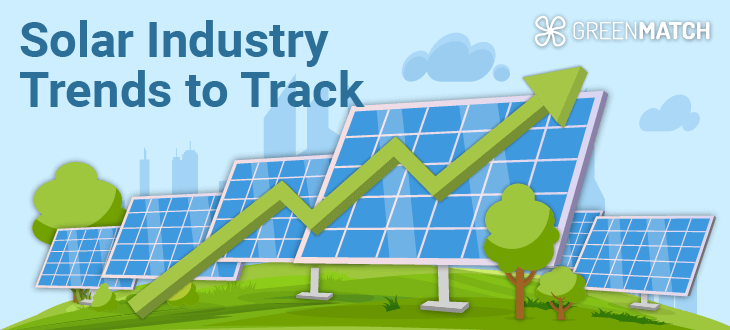- GreenMatch
- Blog
- Advancements in Solar Panel Cell Materials 2025
Latest Advancements in Solar Panel Cell Materials and Technologies 2025


The solar energy industry continues to witness exciting advancements in solar panel cell materials and technologies, pushing the boundaries of efficiency and cost-effectiveness.
In 2025, these developments have been pivotal in enhancing efficiency, reducing solar panel costs, and promoting the sustainability of solar energy solutions. The industry has seen the introduction of novel materials and technologies designed to improve the performance and applicability of solar panels.
These advancements aim to address the limitations of traditional silicon-based solar cells and explore new paradigms in solar energy conversion.
This report presents an in-depth analysis of the most significant advancements in solar panel technologies.
Advances in Solar Panel Cell Materials
Perovskite Solar Cells
Perovskite solar cells have emerged as a leading innovation, offering a promising alternative to silicon-based cells due to their superior light absorption and cost-effective production processes.
These solar cells have achieved lab efficiencies surpassing 33%, with significant developments in stability and longevity. Researchers have focused on enhancing the strength and longevity of perovskite cells, addressing previous concerns about their sensitivity to environmental factors.
Notably, advancements in material engineering and protective coatings have significantly improved the durability of perovskite cells. These enhancements enable some designs to endure harsh conditions and are projected to last up to 30 years.
However, significant limitations hinder widespread adoption. Lead-based perovskites pose environmental and health concerns. Research is actively exploring lead-free alternatives with comparable efficiency. The energy industry continues to witness exciting advancements in cell materials and technologies, pushing the boundaries of efficiency and cost-effectiveness.
Tandem Solar Cells
Layering perovskite materials atop silicon cells and tandem solar cells has achieved efficiencies exceeding 33% in laboratory settings.
Tandem cells consist of two or more photovoltaic materials stacked in a layered structure. This allows for the absorption of a broader range of the solar spectrum, potentially exceeding the efficiency limitations of single-junction cells.
Tandem cells have the potential to achieve efficiencies exceeding 40%, paving the way for higher energy generation per unit area. Different materials can be chosen for each layer, optimising light absorption across the visible and infrared regions.
This synergy between perovskite and silicon materials enables higher electricity production per cell, positioning tandem cells as a potential game-changer in solar technology.
The limitation currently is complex. This is because the manufacturing tandem cells involve more intricate processes compared to traditional single-junction cells, potentially increasing production costs
Thin-Film Solar Cells
Thin-film solar cells, known for their lightweight and flexible properties, have seen significant advancements in 2024. Innovations in materials such as copper indium gallium selenide (CIGS) and cadmium telluride (CdTe) have enhanced their efficiency and versatility.
These cells can now be integrated into various surfaces, including building facades and consumer electronics, broadening the scope of solar energy applications.
They are significantly lighter, offering new possibilities for integrating solar technology into various surfaces. Impressively, they produce 18 times more power per kilogram than conventional panels.
However, the limitations of these ultrathin cells' practical application and durability in diverse environmental conditions are yet to be fully assessed.
Bifacial and Multijunction Solar Cells
Bifacial solar cells, capable of capturing sunlight from both sides, have gained traction due to their potential to increase energy production by up to 30%. Multijunction solar cells are revolutionizing the industry by stacking multiple layers of materials, each attuned to different light wavelengths. This innovative design continues to push the boundaries of solar efficiency, achieving unprecedented performance levels.
Ferroelectric Solar Cells
Tesla's Breakthrough
Tesla's introduction of ferroelectric cells in 2024 has marked a revolutionary leap in solar panel efficiency. These cells offer a 1000x efficiency boost over traditional silicon cells, eliminating the need for PN Junctions and significantly reducing costs to approximately £1.68/W. Tesla's ferroelectric cells have disrupted the market with unprecedented efficiency and affordability.
TPV Systems
Tesla's TPV (Thermophotovoltaic) systems have significantly reduced energy storage costs to less than £7.60 per kWh, challenging traditional solar battery storage's ~£447.53 per kWh. TPV systems surpass turbines by achieving an impressive efficiency of over 40%, and they have no moving parts. These systems are capable of operating at high temperatures, ranging from 1900-2400°C.
This makes them a formidable alternative to nuclear power, especially regarding area efficiency.
Organic Photovoltaics (OPV)
Organic photovoltaics offer a sustainable alternative, utilising abundant carbon-based materials that are less harmful to the environment. The top performers developed to date have only achieved an efficiency of 19.7% for a binary organic solar cell (18.93% certified), significantly lower than silicon panels.
Additionally, large-area organic photovoltaic modules have achieved a certified world record efficiency of 14.5%. These advancements highlight significant progress in the field, approaching the performance levels of conventional photovoltaic technologies.
While traditionally lagging in efficiency, recent breakthroughs in material science have improved their performance, making OPVs a more viable option for green energy solutions.
Quantum Dot Solar Cells and BIPV
Quantum dot solar cells and Building-Integrated Photovoltaics (BIPV) stand at the cutting edge of solar technology. They aim to seamlessly integrate solar power into building materials, revolutionising how buildings harness energy.
These innovations are expected to enhance the aesthetic appeal of buildings and significantly improve energy efficiency, potentially exceeding 25%. Moreover, there is a strong emphasis on utilizing eco-friendly materials, underscoring the industry's commitment to sustainability and environmental responsibility.
New and Emerging Solar Panel Cell Materials
High-Performance Solar Absorber Materials
A Dartmouth Engineering-led study reported discovering an entirely new, stable, and earth-abundant high-performance material for solar absorbers. This material was identified through a unique high-throughput computational screening method that evaluated approximately 40,000 known candidate materials.
The solar absorber material demonstrated promising efficiency in transforming light into electricity. It exhibited high stability in air and water, potentially reducing moisture and air contamination costs.
Tin Zirconium Titanium Selenide Alloys
Research has synthesised a new material, tin zirconium titanium selenide alloys [Sn(Zr1−xTix)Se3], with varying titanium ratios to explore its suitability for multijunction solar cells.
This material closely resembles the ABX3 structure of conventional perovskite materials. It has shown potential in absorbing the infrared spectrum, which is not captured by current solar cells. Capturing a broader range of the solar spectrum could lead to increased efficiencies.
Flexible and Stretchable Solar Cells
The Korea Advanced Institute of Science and Technology (KAIST) set a stretchable solar cell efficiency record. They developed a unique polymer material that allows solar cells to deform significantly without sacrificing conversion efficiency.
This advancement opens new avenues for integrating solar cells into wearable electronics and other unique form factors, enhancing the versatility of solar energy applications.
Key Features, Benefits, and Limitations
High-Performance Solar Absorber Materials
- Key Features: Stability in air and water, efficient light-to-electricity conversion.
- Benefits: Reduced costs related to environmental protection, potential for widespread application due to earth-abundant materials.
- Limitations: The material is in the early stages of development, with further research needed to optimise its integration into commercial solar panels.
Tin Zirconium Titanium Selenide Alloys
- Key Features: Absorption of the infrared spectrum, potential for multijunction solar cell application.
- Benefits: Increased solar cell efficiency by capturing a broader range of the solar spectrum.
- Limitations: Structural stability is limited to a specific Ti/(Ti+Zr) ratio, necessitating careful material composition control.
Flexible and Stretchable Solar Cells
- Key Features: High deformation tolerance, maintained efficiency under strain.
- Benefits: Opens new applications for solar cells in wearable electronics and other flexible formats.
- Limitations: While stretchable cells have achieved record efficiency, further improvements are needed to match the efficiency of rigid solar cells.
Solar Panel Cost
The upfront cost of solar panels in 2024 can range from £5,000 to £17,000, depending on the size and efficiency of the system. Specifically, a 4kW system suitable for the average home costs between £9,000 and £10,000. Advancements in cell materials and technologies are continuously driving down installation costs.
These efficiency improvements make solar power more attractive for homeowners than ever. Moreover, this price variation reflects the significant strides in solar cell materials and technologies. Consequently, these advancements are making solar energy more accessible and cost-effective.
The increased efficiency rates of up to 23% and beyond, as seen in the achieving a commercial-size perovskite tandem cell efficiency of 33%
In Summary
The advancements in solar panel cell materials and technologies in 2025 represent significant strides toward overcoming the limitations of traditional solar cells. Introducing high-performance solar absorber materials underscores the industry's commitment to innovation. Tin zirconium titanium selenide alloys represent a significant advancement in solar technology. Additionally, developing flexible solar cells highlights a sustained focus on sustainability.
These developments promise to enhance the efficiency and applicability of solar panels and pave the way for new solar energy applications. As the solar industry continues to evolve, these materials and technologies are expected to play a crucial role in shaping the future of renewable energy.

Inemesit is a seasoned content writer with 9 years of experience in B2B and B2C. Her expertise in sustainability and green technologies guides readers towards eco-friendly choices, significantly contributing to the field of renewable energy and environmental sustainability.
We strive to connect our customers with the right product and supplier. Would you like to be part of GreenMatch?

